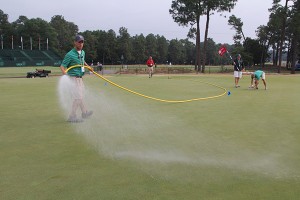Keeping an “Open” mind when golfing
 Watching the back-to-back men’s and women’s U.S. Opens took me down memory lane to the days when I worked at Disney and we hosted the Oldsmobile Scramble and Disney Classic back-to-back.
Watching the back-to-back men’s and women’s U.S. Opens took me down memory lane to the days when I worked at Disney and we hosted the Oldsmobile Scramble and Disney Classic back-to-back.
Many challenges can pop up when hosting events back-to-back. One positive for Pinehurst No. 2 was that the men’s U.S. Open and the women’s U.S. Open played at different yardages. The landing areas were different for the men and women, thus minimizing divots that might otherwise affect the players in the second event.
At Disney, that wasn’t the case. While the scramble event consisted of amateurs, each group also had a pro player. Thus, using the best drive, they all hit from the “pro landing area.” So divot details were crucial in keeping those areas playable.
Like Pinehurst we did have several golf maintenance crews that could chip in along with other departments to provide help cleaning up the course before and after each round, so personnel numbers were not a big issue.
The biggest fear factor we dealt with was the weather. In October, Florida is still in hurricane season and it was too often we had to bail out bunkers and repair lots of washed out bunker faces. The other negative was all of the trucks and other vehicles supporting the tournament infrastructure making huge ruts when servicing bathrooms and food stations on the course.
I know Bob Farren’s crew at Pinehurst was amped up and eager to pull this history-making event off in fine fashion, as were our guys back then. But when it’s over and the adrenaline wears off it seemed like everyone had a big let-down feeling. We learned all about working under the mobile diesel powered lights early in the morning and late at night. We had morning crews and night crews. No days off until it was over.
Once the bright lights go away, it’s a challenge to keep that same level of intensity. Of course, it is nice to get back to a more normal sleep schedule and actually see your loved ones at dinner in the evenings.
The other big factor in this hallmark event at Pinehurst of course is the retro-design by the Coore and Crenshaw team. I happened to meet them while attending a TOCA (Turf and Ornamental Communicators Association) conference at Pinehurst a few years before the project started. The sustainability factor of the new, or should I say “old,” design is certainly something to consider. It saves water, fuel and labor and those costs are very critical in today’s touchy golf market.
One lesson we may learn from this major event/golf marathon, is that challenging, playable and enjoyable golf courses don’t have to be expansive manicured fields of turf.
With water-use and availability regulations front and center these days, will golfers accept some brownish, off-color, scalloped edges that sometimes come with single row fairway irrigation? Maybe by going back in time, Pinehurst can open the door to a “less is more” future.
The general impression I’ve seen is a mixed reaction to the look of the course. Those who get it love it, but those who don’t wondered why the crew at Pinehurst didn’t just crank up the water.
People are funny and most don’t like change. What works for Pinehurst, a historic icon of early golf in America, may not resonate with folks living in a NIMBY (not-in-my-backyard) world. But it still makes for a great opportunity to discuss these issues with golfers, because they’re certainly not going away.
Photo: Seth Jones










